Chimney Liner Cost
Last updated 24th July, 2024
Do you need to know more about chimney liner installation costs?
We have all the answers for you in this chimney liners and flue liners cost guide. If you need a new metal chimney flue or even concrete flue liners this is the place. Not only do we provide the chimney liner cost but also the labour fees expected for installing it. On average, depending on type, you should expect to pay between £800 - £1500 for full chimney lining.
Keep reading below!
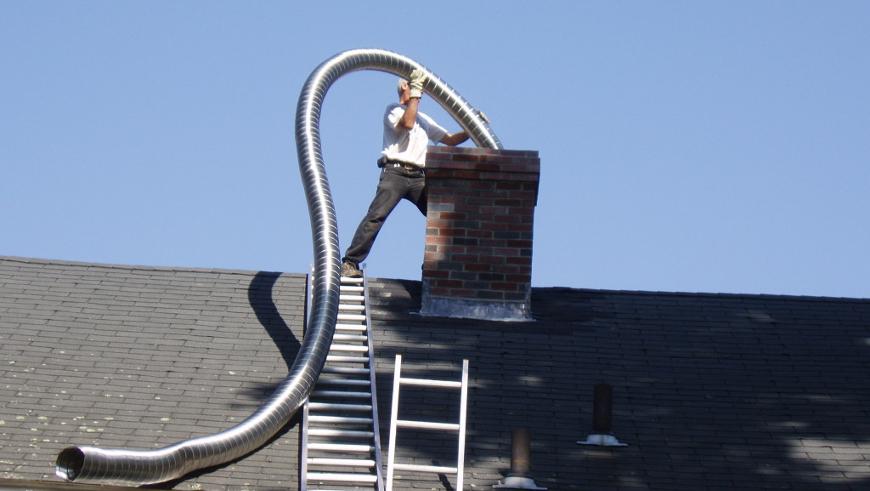
How Much Does it Cost to Line a Chimney?
Wood burning stoves are becoming very popular in the UK, and many homeowners are investigating whether they can use their existing traditional chimneys for modern solid fuel stoves.
But there are several reasons why an older chimney may need lining.
Sometimes the existing flue is simply far too large for modern appliances, but the main reason is that many old chimneys will fail the smoke test which means that the flue is leaking smoke and fumes into the building.
In most cases, if you want a modern, efficient wood burning stove, you will require a class 1 flue liner which is either stainless steel, Thermocrete or rigid pumice. Flexible 316 grade stainless steel liners are the most popular lining for an existing chimney as they are the most cost-effective and the work can usually be carried out in one day or less with little upheaval or mess.
A stainless-steel liner installed correctly will last many years, and they are often guaranteed for 10 years or more. Gas stoves only require Class 2 Flue Liners which are much cheaper and lighter, yet still, meet safety regulations.
There are several methods of chimney liner installation, and it can depend on the condition of the chimney, the age of the property or the appliance that it will be servicing.
Table of Contents
- How much to line a chimney?
- Labour costs and time frames
- What is a chimney liner?
- What does lining a chimney entail?
- Cost affecting factors of installing a chimney liner
- Does my chimney need lining?
- DIY chimney lining
- Chimney liner options
- Planning permission & building regulations
- What to look for when choosing a chimney liner
- Chimney liner insulation
- Chimney liner maintenance and cleaning
- Who are HETAS?
- Cost of removing chimney lining
- FAQs
- How to find and hire a tradesman to line a chimney
- Sources
Chimney Liner Prices
Whether in a terraced townhouse or a stately home, the most important aspect of a working chimney is that the flue is effectively removing harmful gases and particulates from the property. Therefore, choosing the right system is very important.
| Type of chimney liner | Average Cost |
|---|---|
| Stainless steel flexible | £500-£800 |
| Stainless steel (rigid) | £850-£1,000 |
| Clay | £1,100-£1,600 |
| Concrete | £1,000-£1,500 |
| Pumice | £900-£1,300 |
| Ceramic pumped system | Bespoke costs |
Supply Costs
| Type | Cost per m | 6m Length | Closure Plate | Supply Cost |
|---|---|---|---|---|
| Stainless steel flexible | £25-£30 | £150-£250 | £35-£45 | £200-£300 |
| Stainless steel (rigid) | £80-£90 | £500-£600 | £35-£45 | £550-£650 |
| Clay | £90-£100 | £500-£600 | £35-£45 | £600-£700 |
| Concrete | £70-£80 | £430-£500 | £35-£45 | £460-£560 |
| Pumice | £60-£70 | £370-£470 | £35-£45 | £400-£500 |
| Ceramic pumped system | Bespoke costs | Bespoke costs | £35-£45 | Bespoke costs |
Additional Costs
Chimney cowls can cost between £10-£60 depending on whether you want anti-downdraught capability or a bird guard or just a simple cowl. It's relatively simple to install a chimney cowl.
Sweeping the chimney prior to the lining is essential and will cost approximately £50 for one chimney.
Register plate or closure plate is a sheet of fire retardant material, usually galvanised steel, which is installed above a stove at the base of the chimney. This plate prevents heat loss from the stove up the chimney and protects against debris falling down the chimney onto the stove. The cost is in the region of £35.
Stove pipe or connecting pipe is a length of vitreous enamel made from carbon steel and then coated with vitreous enamel inside and outside. It should only be used to connect the appliance to the flue liner. Vitreous enamel stove pipe price is approximately £33 per metre.
Repointing may be necessary on older chimneys as the mortar tends to deteriorate over time with fluctuating temperatures. The cost to repoint a chimney including scaffolding is approximately £600.
Before fitting a liner, chimney sweeping is required for all chimneys, to keep the mess to a minimum and check the flue is clear of blockages. Installing a new chimney liner against a dirty chimney can cause a chimney fire. Having your chimney swept prior to installing the liner is usually a condition of any guarantees offered. Cost is approximately £50-£70.
| Additional Components | Average Cost |
|---|---|
| Chimney caps | £20-£30 |
| Base support bracket | £15-£25 |
| 45° elbows | £30-£40 |
| Clamps | £5-£15 |
| Nose cone | £3-£10 |
| Stove to flexible liner adapters | £15-£25 |
Cost Breakdown Calculator
Individual costs for installing a stainless steel chimney liner - Total Cost: £800
Materials
£400
Tradesmen
£360
Waste Removal
£40
Labour Costs and Time Frames
The cost of labour for the work will be an average of £150-£350 per day; normally two people will be required.
There is currently no legal requirement for a HETAS registered installer to be hired to line a chimney and it is legal for a homeowner to do the work themselves. However, it is necessary for Building Control to sign off the work, and this service must be paid for. The fees vary from one local authority to another but may be in the region of £200-£300.
The most common flue liner, flexible stainless steel, will usually only take 1 day to fit. Twin walled rigid stainless steel lining is more involved and will take approximately 1-2 days.
Concrete, clay and pumice flue liners which fit together in a tongue and socket system are more labour intensive and may take 4-5 days. The ceramic pumped lining system can normally be done in 1 day.
What Can Change Labour Costs and Time Frames?
Issues such as structural defects inside the chimney stack can mean that the installation may not be straightforward and could delay the completion of the work.
There may also be items that have become dislodged within the chimney such as bricks, stones or bits of broken clay liner. These will have to be removed before the chimney can be swept which should always be done before the flue liner is installed.
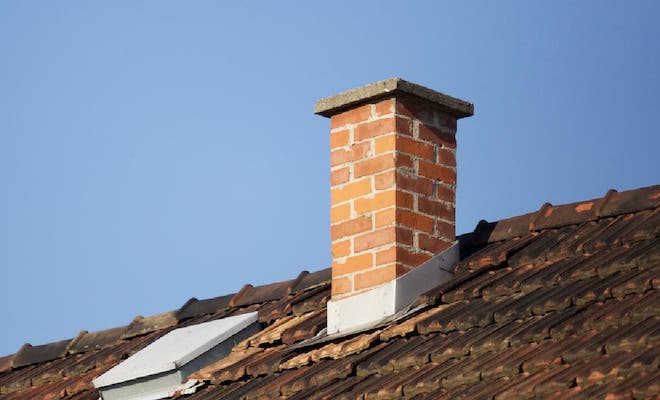
Weather conditions should be suitable for work at height to be completed safely, and high winds and/or rain can cause disruption to an installation.
Any delay to the installation of the chimney liner will add to the labour cost and cost of scaffolding if you have hired some for the work.
What is a Chimney Liner?
A chimney liner’s function is the safe and effective removal of the combustion gases and particulates from the appliance or heat source to the outside atmosphere.
Choosing a Flue Liner
Once the chimney has been cleaned, the next step is to decide what type of liner to put in. If you are simply replacing like for like, then the decision is straightforward.
However, it is advisable to research the best possible replacement according to your budget, the appliance the flue liner is servicing, the current condition of the chimney and the potential life expectancy of the replacement flue liner.
The cheap option regarding initial outlay is to fit flexible stainless-steel type which costs on average £26 per metre, but this will have an average life span of 10-15 years which could see you repeating the process in the future.
Pumice and ceramic liners have an expected life span of 50-60 years but are more than twice the price at approximately £60-£70 per metre. The pros and cons would be dependent on each individual project.
| Type of Chimney Liner | Type of Appliance |
|---|---|
| Stainless steel – single skin | Wood, multi-fuel, gas, biomass |
| Stainless steel – rigid | Wood, multi-fuel*, gas, oil, biomass, condensing boiler, non-condensing boiler |
| Clay | Wood, multi-fuel, gas, oil, biomass |
| Concrete | Wood, multi-fuel, gas, oil, non-condensing boiler |
| Pumice | Wood, multi-fuel, gas, oil, non-condensing boiler |
| Ceramic pumped system | Wood, multi-fuel, gas, oil, biomass, condensing boiler |
*Multi-fuel stoves look very similar to a wood-burning stove but can burn coal, wood pellet or peat as well as wood. They normally have a grate for the fire to sit on and a removable ash pan.
The words chimney and flue are sometimes used to mean the same thing. In fact, the chimney is the brick or masonry structure which houses the flue.
The flue is the channel through which the gases and particles of combustion are discharged into the outside atmosphere.
The liner is the material that covers the interior of the flue. As discussed, there are various types of flue liner composed of different materials with a wide range of cost, suitability for purpose, and durability.
Negative pressure draws the combustion by-products up through the flue and out of the top of the chimney. This works by the difference in air pressure from the appliance e.g. stove, wood burner etc. to the top of the chimney, the difference in temperature of the flue gas and the outside air, the condition of the flue and the route of the chimney which should be as straight as possible.
Any defects in any of these components may result in dangerous gases going back into the room, deposits of soot, tar and creosote coating the flue liner and potentially a chimney fire.
Prior to 1966, there was no requirement for chimneys to have a flue liner and were normally constructed using cement render, which over time is prone to deterioration. After this date, ceramic and concrete lining was commonly used.
A Chimney Liners Function
For a flue to adequately fulfil its purpose, the temperature of the flue gases should always be between 150°C-450°C. Temperatures lower than this will cause condensation inside the liner which allows tar and soot to deposit on the sides of the liner. These deposits are corrosive and will damage metal parts of the liner and of the appliance.
Allowing the soot, tar or creosote deposits to accumulate inside the liner greatly increases the chances of a chimney fire and can halve the life of a metal flue liner. Therefore, it is very important to avoid burning wet wood and not to allow a ‘slumber burn’ in the appliance.
A slumber burn is when the fuel is burned at a lower temperature for longer periods e.g. overnight and not only will it cause a build-up of soot deposits but will also increase the level of carbon monoxide produced which is potentially harmful.
The most important function of a chimney liner is to ensure that no gases escape from the flue into the property. As carbon monoxide is an odourless and colourless gas, it is imperative that a carbon monoxide alarm is fitted where any fuel-burning appliance is used.
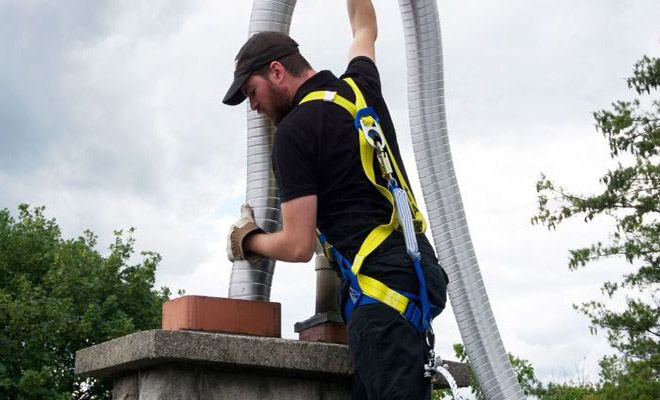
By installing a good quality chimney liner, the risk of any harmful substances making their way through gaps or breaks in the chimney is substantially reduced.
While the cost of lining a chimney may seem expensive, it can ensure the optimum performance of the attached appliance. An ineffective flue can adversely affect the output of a wood-burning stove or fire with poor up draught and draw.
Older properties can have larger chimneys, sometimes over 200mm, and this is not suitable for most appliances, which will need a much narrower flue to work well. By installing a chimney liner of small diameter, it is possible to have the wood burner or gas fire that you want.
A well-installed flue liner will make the maintenance of the chimney an easier task. Sweeping a smooth interior is more effective than one which is rough or eroded. A clean chimney liner means the appliance it serves will work well, and there is less risk of a chimney fire.
Staining, inside or outside the building, from creosote or tar deposits which seep through old chimney walls can be prevented by installing a chimney liner.
What Does Lining a Chimney Entail?
Before installing a chimney liner of any type, it will be necessary to sweep the chimney unless it is in a new build property. This should be done by a professional chimney sweep who will have the correct equipment and training.
The average cost of sweeping a chimney is approximately £50-£70 although this does depend on how long since it was last cleaned and how much work is involved.
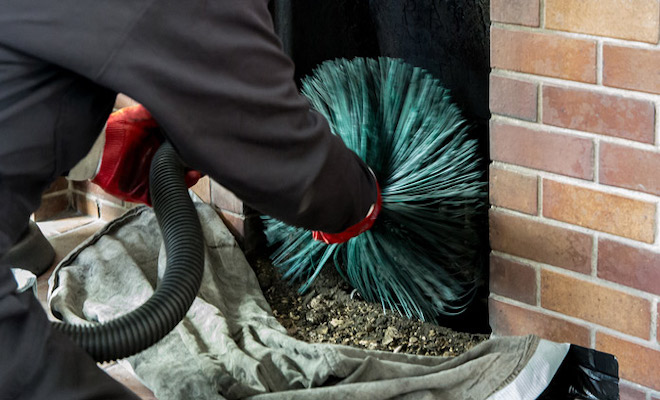
Some chimney sweeps will use a camera to look inside the chimney before sweeping and this can be useful if you are preparing to install a new flue liner in order to gauge the condition of the chimney. The state of repair of the existing chimney liner may dictate what type should be used to replace it. Of course, your budget will also be a deciding factor.
Sweeping your chimney can be done as a DIY job if you have the right equipment and are prepared to deal with the mess.
After the chimney is swept a smoke test should be carried out to determine whether there are any faults which would allow combustion gases to leak through the walls of the chimney.
Rigid stainless-steel flue liners, as well as most concrete, clay, or pumice liners are installed in sections which are lowered down the chimney by rope. These sections are then designed to lock together.
Most stainless steel rigid chimney liners have a lowering pipe which is designed to take the weight of the 1-metre length pipes up to a maximum of 15 lengths which are added one at a time and then lowered down the chimney by rope.
Pumice flue liners, concrete and clay liners are installed by lowering the liners down the chimney by rope. Once in place, the gap between the liner and the wall of the chimney is infilled with an insulating material such as vermiculite.
Cost Affecting Factors of Installing a Chimney Liner
Scaffolding will not normally be required and won’t usually be a factor in the chimney liner installation cost. Most installers will use roofing ladders and safety harnesses.
However, if it is required, scaffolding will cost in the region of £70 per day depending on the region of the UK with London and the Southeast being more expensive due to demand.
Waste is a definite cost as there will be old lining to remove; however, it shouldn’t require a skip or other large removal system. The installer may include the cost of waste removal into his quote, or you can arrange for a dedicated man with a van to take it to the appropriate waste disposal site.
It will depend on how much rubbish has been generated in order to allow for the cost but on average will be 10% of lining a chimney cost.
The size of a chimney or rather its length will determine how much it will cost to install a flue liner. There may also be many flues in one chimney as with older historical properties.
An average 6 metres of flexible stainless steel flue liner will cost on average £500 including a sweep and closure plate. Chimney flue liner cost will, therefore, depend on how many flues require lining.
Location within the UK is always a factor which can affect the cost of work to a property. Prices in London and the south-east will always be more expensive than other areas as demand is higher and population denser. Property prices are also higher in London, and the surrounding area and any improvement work costs will be reflected by this fact.
The type of liner used to line a chimney will be the main factor in how much the total price will be. Stainless steel chimney liner cost is relatively inexpensive when compared to the other materials, although the durability is not on the same scale.
As previously noted, the flexible flue liner is the most inexpensive but with a reasonably limited life expectancy. While the pumice and ceramic systems have an impressive 50-60-year guarantee, this quality is reflected in the chimney liner cost.
The type of appliance that the flue will serve will also contribute to the difference in overall cost. The cost of lining a chimney for a gas fire will not be the same as the cost of lining a chimney for a wood burner.
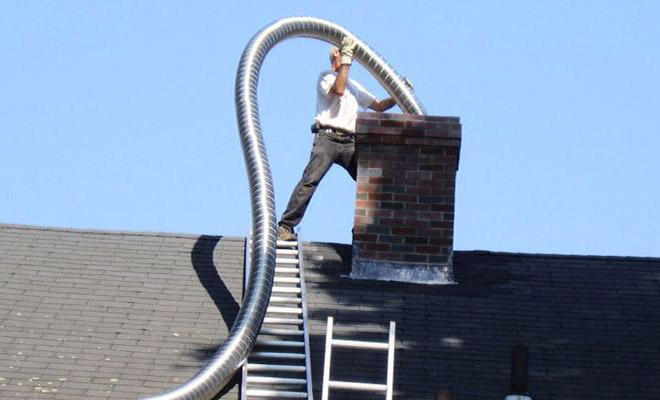
This is because the type of flue liner that will work for a gas fire is not the same as one that will work for a wood-burning stove. Single wall flexible stainless-steel liners are adequate for lining a chimney used by a gas fire, but if you wanted to replace the gas fire with a wood burner, then the flue liner would have to be removed and replaced.
This is because the liner would not be able to withstand the heat from a wood or solid fuel stove.
Waste removal may be necessary if an old liner has been removed from the chimney.
While it is doubtful that a skip would be necessary unless you are demolishing and rebuilding the chimney, some waste removal cost may be incurred. A 6-yard skip in London will cost approximately £230 while a man and a van in the same area will be around £150.
Scaffolding may be required if the access to the chimney is deemed unsafe by roofing ladders or a cherry picker especially if structural or pointing work to the chimney stack is required prior to installing the flue liner. A scaffold tower is more practical than full-scale scaffolding which usually has a minimum hire period of 6-8 weeks.
Location within the UK will influence prices with London again being 2-2 ½ times more expensive than the rest of the country. The cost to hire a 6-metre scaffold tower in London for a week is on average £150-£200.
Some of this cost will depend on the type of stove you choose, and the first consideration should be the heat output required for the size of the room. This is done by measuring the cubic capacity of the room in either feet or metres (length x width x height) and using a calculator to determine the required kW.
Apart from the stove itself, a typical installation will include a chimney cowl, flue liner, adapter (appliance to flue liner), closure plate, fire rope and fire cement as a sealant. A wood-burning stove must also sit on a hearth for heat protection. An average cost for installing a wood-burning stove is in the region of £2,100.
Does My Chimney Need Lining?
A chimney may need lining or relining for various reasons. There has been a significant rise in the number of wood burners being installed in UK homes and old fireplaces being opened up again for the use of these appliances.
Unlike other parts of Europe where wood is abundant and relatively cheap as a fuel, the price of logs for wood burners in Britain can be prohibitive, but they are an aesthetically pleasing addition to any home especially on a cold, wet winter evening. Therefore, their popularity shows no sign of diminishing any time soon.
Installing a wood-burning stove or gas flame effect fire is probably the most common reason for needing to line or reline a chimney. As mentioned, the type of flue liner chosen will depend on the type of appliance that it needs to service.
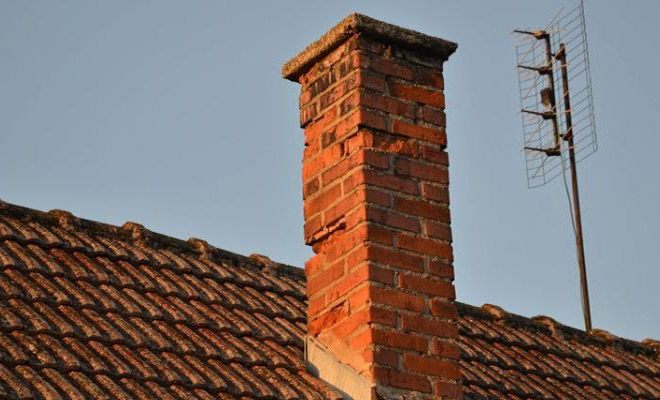
Some people prefer the comfort of an open fire as opposed to an enclosed appliance such as a wood burner. In this instance, the flue will also need to be checked to ensure that there are no obstructions, structural defects or causes for concern with using an open fire in the fireplace.
Again, the chimney should be swept, inspected and a smoke test carried out to gauge the effectiveness of the flue and ensure that no smoke, fumes or gases are escaping through the chimney wall into the property. If this is the case, then the flue will need to be lined for safety, optimal performance and energy efficiency.
Having an unlined flue can not only cause ingress of smoke but also harmful Carbon Monoxide to the property. This gas is undetectable by smell, and only a CO detector will pick up any emissions from a fuel-burning source. A well-sealed and functioning flue liner will eliminate this problem.
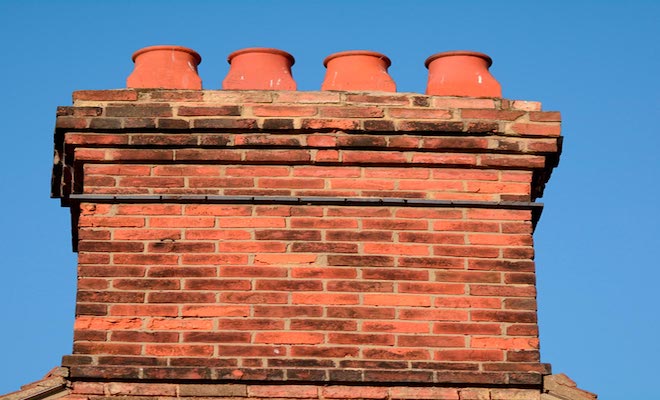
For any fuel-burning appliance to work correctly, the chimney should produce good ‘draw’. This is the negative pressure pull of air upwards through the flue taking any noxious gases and other combustion by-products with it. A badly corroded liner or chimney with heavy creosote or tar deposits will prevent good draw.
This will not only affect the performance of the fire but also can cause smoke to escape into the room making soft furnishings smell of smoke, staining the area above the fire and polluting the air quality of the room. Obvious signs such as this may be one of the first indications that a new chimney liner is required.
Insulation for the chimney is another reason why a new chimney liner would be installed. A poorly drawing chimney can be due to cool flue temperature or to an excessively large flue opening.
Installing a new chimney liner will insulate the chimney and improve the temperature maintenance of the flue to allow flue gases and smoke to be drawn upwards out of the chimney. A property with a thatched roof is required to have an insulated chimney liner for safety and home insurance purposes.
If you have attempted to have your chimney swept and the chimney sweep has discovered heavy tar and/or creosote deposits, he may be unable to certify the chimney as safe to use. Many insurance companies require a certificate from a registered chimney sweep if you have a fuel-burning appliance installed in your property.
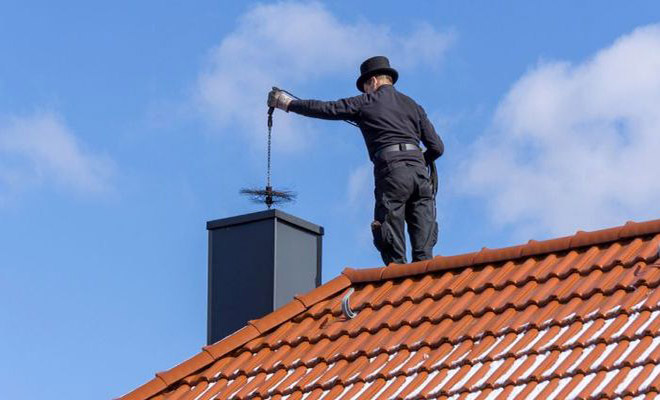
Without this, any claim may be disputed. If the chimney sweep is unwilling to issue a certificate because of the condition of the chimney, then a new flue liner may be necessary.
Moving into a new home may require updating or installing a chimney liner if you wish to use an open fire or install a wood burner or similar appliance. The existing installation may not be compliant with the type of fire or stove that you wish to have.
There is currently nothing to prevent a homeowner or general builder from installing a chimney liner although it will need to be signed off by the building control department of the local authority. This service will incur a fee which varies between local authorities.
For safety and to ensure that the chimney liner is installed correctly and safely it is advisable to have a HETAS (Heat Equipment Testing and Approvals Scheme) registered installer do the work. They can self-certify and do all the paperwork; this service will be included in the cost of the work.
There is also the peace of mind that the installation has been carried out by someone with the backing of a recognised approval body for solid fuel heating appliances, fuels and services.
Whether you do the installation yourself or it is done by a HETAS installer, a certificate of compliance will be required if you sell the property.
What Types of Chimney Need Lining and Which Don’t?
New chimneys may need relining if they have an existing gas flue liner that will not be suitable for use with a wood burner or multi-fuel stove.
Older chimneys may require a new liner for various reasons such as gaps in the chimney wall which allow smoke and gases into the building.
Chimneys which have lost some of their structural integrity may allow staining either inside or outside the property from a build-up of condensates such as creosote or tar to seep through.
A chimney may be poorly insulated especially older chimneys with larger flues. Installing a modern flue liner will improve the insulation of the chimney and improve the performance of any appliance which it services.
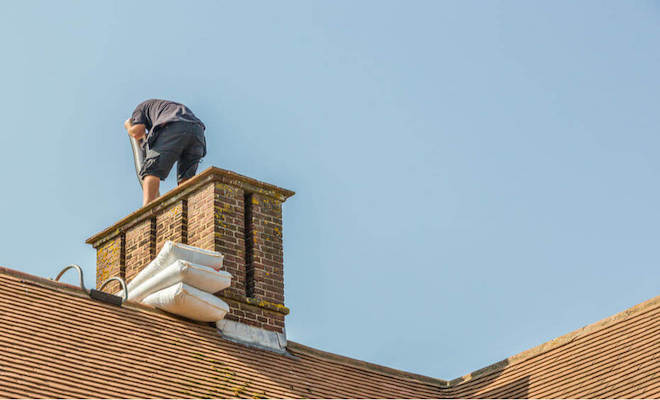
Existing degraded liners will result in poor up draught, and the flow of combustion gases can be disrupted by this. This will mean the appliance or fire will not function correctly and can result in back draught bringing smoke and fumes into the room.
If a chimney has been properly inspected, swept, and smoke tested, and no-fault or smoke ingress to rooms has been discovered, then there is no legal requirement to install a flue liner. If a competent person has passed the chimney as safe and fit for purpose, then there should be no need to fit a flue liner.
Most new builds with chimneys will have been lined with concrete or pumice liners which are suitable for wood, gas or multi-fuel stoves and will not need any additional flue liner.
Why Does an Old Chimney Need Lining?
Old chimneys have a lot of potential inherent problems when brought back into use either with an open fire or with the installation of a wood burner or gas fire. The most obvious problem is that the chimney is aged and has most likely deteriorated over time.
The materials used to line chimneys years ago were not designed to last generations, there was no such thing as building standards to adhere to, and maintenance was not deemed a priority.
Chimneys are exposed to heat, cold, chemical reactions and condensation, all of which will lead to material degradation and eventual failure. The masonry chimney stacks of older properties were lined with a mortar type substance called parge to protect the underlying brickwork.
Constant exposure to alternate states of heat and cold will cause expansion and contraction of the mortar, and over time, cracks will emerge. The integrity of the flue lining will be lost and need to be replaced if the chimney is to continue to be used.
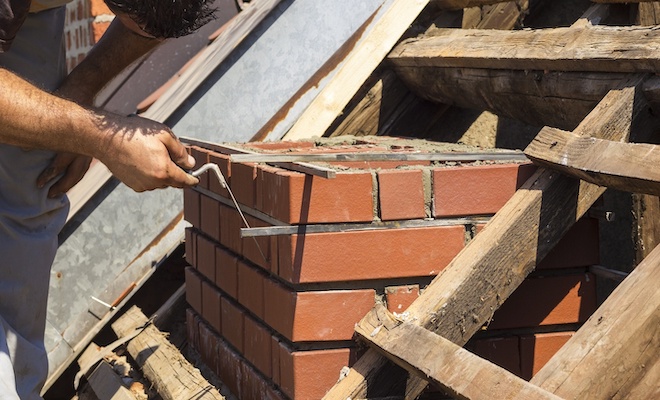
Within older buildings, the chimney shaft would have been used for an open fire, and the flue size would have been much larger than that for a modern wood burner. The amount of heat loss from an open fire through a chimney without a modern flue liner is approximately 70% whereas efficient modern fuel burners will only lose 20-25% of their heat up the chimney.
This is due to the diameter of the flue liner, which allows for greater flue gas temperature, better up draught and improved performance of the fire or stove.
Unlined older chimneys are usually cold because they have no insulation. This impedes the rise of the combustion gases and condensation forms which in turn will create tar or creosote deposits on the flue liner. Creosote and tar are very difficult to remove and can block the flue which will create a safety issue as not only does it prevent the total discharge of the flue gas but it can cause a chimney fire.
Signs and Symptoms That a Chimney Needs Lining
Any property with a fuel-burning appliance must have a carbon monoxide detector installed in the same room. If the alarm is activated, it means that there is carbon monoxide escaping into the building.
This is extremely serious, and the appliance should be turned off immediately, doors and windows opened for ventilation, and a competent person should be brought in the check the appliance and the flue.
The fire or stove should not be used again until it is deemed safe to do so by a competent person, preferably a HETAS engineer. The cause may be that the flue is not working properly and needs to be replaced. Carbon monoxide is a deadly, odourless gas and extreme caution needs to be taken if there is a leak into a property as it can and does kill.
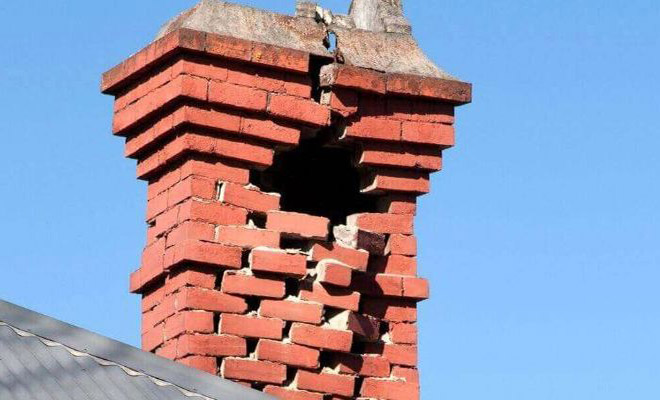
Perhaps the most obvious sign that a flue liner is not operating as it should, is smoke coming back into the room where the fire or stove is situated. This is caused by poor draw, and the result is back draught taking the smoke down the chimney rather than up. The flue may be in bad condition, blocked by tar deposits or not present at all and will need to be replaced.
If there are gaps and holes in the masonry of a chimney, it is possible that tar and creosote can seep through and cause staining to the interior or exterior of the building. This means that the combustion gases can also escape, and this is a potential safety issue. It also indicates that the chimney is not drawing the air out effectively, and the appliance will not be working at its optimum.
Visual inspection of the chimney and flue can reveal potential problems. Masonry degradation of the chimney stack could mean that debris can fall into the flue either causing damage to the liner or a blockage. Getting the chimney cleaned at least once a year by a professional chimney sweep should also alert you to any issues with the flue liner.
Stainless steel flexible liners have approximately 10 years guarantee, and if not maintained regularly they can become corroded by acidic gases and particles adhering to the interior of the liner.
A very serious sign that a chimney needs lining or relining is a chimney fire. Without regular sweeping soot, tar and creosote deposits on the inside of the flue accumulate and can ignite causing a chimney fire. This can spread to the roof or adjoining properties. Damage to the structure of the chimney stack, chimney breast and obviously the flue liner can be substantial.
The thermal shock to the liner can cause any type of liner to crack. Stainless steel flue liner manufacturers recommend that the liner is replaced following a chimney fire.
Do I Need to Line my Chimney When I Get a Log Burner?
A chimney must be free from defects and suitable for the use of a log burner. This means that there should be no leaks through the walls of the chimney following a smoke test, and the size of the flue needs to be correct for the type of log burner being installed. If these conditions are not met, then a suitable flue liner must be put in.
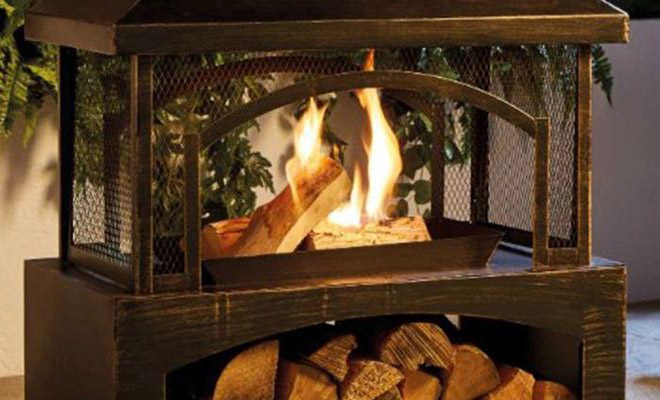
The cost of lining a chimney for a wood burner is between £500-£1,100 depending on the type of flue liner chosen. All are suitable for a log burner apart from the single skin stainless steel flexible liner which is only suitable for gas appliances.
Is it Required for Health & Safety Reasons?
A well-sealed flue will ensure that the combustion gases and particles will be expelled out of the chimney, thus making sure that none can penetrate living or sleeping areas of a home. This is naturally of paramount importance when considering lining or relining a chimney.
There are other benefits, however. The chimney will perform better with a suitable flue liner as will the attached appliance. The outlay to fit a wood-burning fire or stove is not inconsiderable, and it is sensible to have a suitable and compatible flue which will ensure the appliance works properly and efficiently.
DIY Chimney Lining
If you are determined to do this job on your own, then sliding the liner in from the top is the easiest method of installing a chimney liner. But remember that you must sweep the chimney first as loose soot is still a fire hazard even with a new liner, plus if the chimney is not swept then fitting the chimney liner will produce lots of soot and dust.
In addition, if there are multiple chimney pots, then sweeping will also tell you which pot belongs to your fireplace.
To avoid the cost of scaffolding or wearing a climbing harness, hiring a cherry picker is usually the easiest way to access the chimney pot. You then drop a rope down the chimney and feed the liner down whilst your assistant pulls it down from inside with the rope.
Expect to pay around £200 for a cherry picker, hire for one day, with each subsequent day costing around £100. If you cannot reach the chimney pot using a cherry picker then scaffolding is the only other safe option (though professionals will sometimes use ladders and roofing ladders with a professional harness and the associated safety equipment).
If you cannot get the liner to fit down the chimney and cannot break through the wall to make room, then you may need to have the chimney concrete-lined instead of using a stainless-steel liner.
It is possible to line a chimney or replace an existing liner yourself. The work will need to be inspected and signed off by the Building Control department of your local authority, and a fee will be chargeable.
Although you do not need to use a professional installer if you do not feel confident about doing the work, then it is advisable to let an experienced person do it instead. As a large proportion of the work is done at height, you must ensure that you are comfortable with this and that you have the correct safety equipment in order to carry out the work.
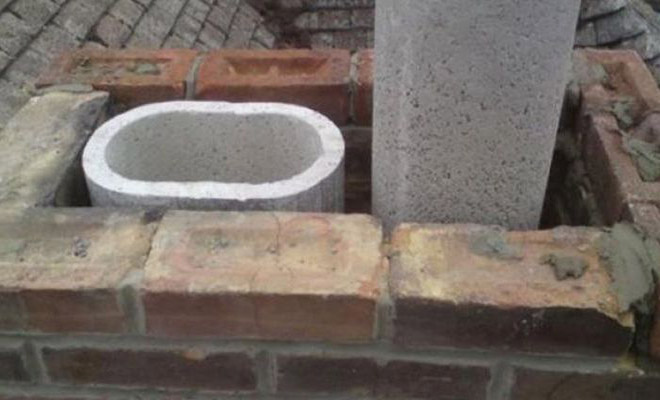
Potential damage to your roof by walking on tiles or slates should also be considered. Professionals will use a roofing or ‘duck run’ ladder to avoid breakages, and you may want to invest in one if you intend to line the chimney yourself.
It is not recommended to attempt to line or reline a chimney unless you are qualified. Although there are instructions available on how to do it yourself, there are several issues with this approach that should prohibit anyone from trying to do so.
The safety aspect is the most obvious. Not only does the installation of the chimney liner have to be done at height, there is the possibility that the liner will not be fitted correctly or that it becomes inadvertently damaged in the process.
Working at height comes with its own risks and safety regulations and only those who have the right equipment such as safety harnesses, proper roofing ladders or scaffolding should be attempting to work in this environment. Not only could you damage the liner but unless you have the correct ladder for walking on the roof, there is the risk of damage which may mean having to replace your roof tiles.
The potential for the incorrect installation or damage to the liner could mean that the liner will not be working effectively and may pose a danger to health and life if combustion gases are escaping from an ill-fitted flue liner.
While the price for a chimney liner installation may seem prohibitive for something that can, legally, be done by a homeowner, safety should be the primary consideration. HETAS engineers are qualified, experienced and can sign off their own work on an installation, thereby giving peace of mind.
Planning permission will not be required unless the property is a listed building in which case you should contact your local authority for clarification.
Downfalls to DIY Installations
As chimney liners cost between £500-£1,100 there may be the temptation to cut the overall outlay by doing the installation as a DIY project. However, there are disadvantages to doing so. A fuel-burning appliance within a property is a source of potential danger if one element of the installation is not done correctly.
The internet is full of videos about how to line a chimney, often citing flue liner cost as a reason. Some are better than others and should not really be taken as justification for disregarding a professional installation. Every chimney will be different, and the condition of each flue will be equally different, so no amount of ‘how to’ videos are going to prepare you for your project.
This is the benefit of having someone who does chimney lining as part of their profession. It is likely that they will have worked on a variety of chimneys, flues and properties and will have seen most issues before. There is no substitute for experience, and when it is in relation to something which has the potential of danger, there is an even greater reason to use a professional.
An incorrectly or badly fitted flue liner may contribute to poor performance from the attached appliance, leaking of smoke and carbon monoxide into the building.
There is no special qualification needed to install a chimney liner, and it can be done by a homeowner or general builder. However, any change to a chimney such as replacing a flue liner in conjunction with the installation of a heating appliance is considered controlled work and needs to be inspected by the Building Control department of the local authority.
They will then issue a certificate of compliance to state that the work has been carried out according to Building Regulations. HETAS engineers will complete this paperwork if they carry out your fire, stove or boiler installation.
There is no legal requirement for a HETAS or other professional installer to line or reline your chimney, and it is possible to do it yourself. If you have a wood or multi-fuel burning appliance installed in your home, you should check that your home insurance covers this.
Jobs a Homeowner Can Do To Cut Costs
You may want to have a professional installer line or reline your chimney, but if you feel confident, there are some preparatory jobs that you could do to reduce the expense.
The first thing would be to sweep the chimney. Of course, if you don’t own chimney brushes, then this will be an additional cost. It’s also quite a messy job, so being prepared is essential. Putting down dust sheets on the floor and sealing the fireplace with plastic sheeting and tape. Some wood and multi-fuel burners can either be swept through the flue or through a hatch.
Attach the chimney brush to the first rod and feed it into the flue, then cut a small hole in the plastic sheeting for the rod to fit through and so you can add the additional rods. It is a good idea to use heavy-duty plastic sheeting to prevent the hole enlarging as you are moving the rods up the chimney. You can also reinforce the hole with strong tape.
Chimney brushes cost on around £18-£20 while the flexible rods can be bought in packs of 6, 8 or 10 to facilitate different flue lengths. They can, of course, be bought individually as well and cost approximately £10-£12 each for nylon flexible rods and around £5 for polypropylene (drain) rods. Drill driven kits are available for less than £50 with 6 metres of rods.
If you are replacing a corroded or broken flue liner, then you could remove this yourself if it is safe for you to do it. Stainless steel flexible flue liners can have very sharp edges, especially if they are broken so you should always wear gloves when handling them.
Working at height should always be done with safety foremost, so suitable ladders, scaffold tower or cherry picker should be used where possible. Roofing ladders cost around £150-£200 for a 3m-5m ladder. The cost to hire a scaffold tower in London for a week is on average £150-£200. Hiring a cherry picker will cost approximately £100-£250 for a day depending on the size and model.
It may be worthwhile to weigh the costs of buying and hiring equipment to do some of the chimney liners work yourself in order to save money against what you are paying out. You may find that it costs you just as much or more and you have to do the work yourself.
DIY Flue Liner Kit Costs
The kit comprises stainless steel flexible flue liner, an adaptor to connect a stovepipe to the flexible flue liner, a steel register or closure plate with appropriate fixing brackets, a chimney cowl with bird guard, a nose cone and fire cement.
| Length | Liner diameter | Grade | Price | Liner diameter | Grade | Price |
|---|---|---|---|---|---|---|
| 6 metres | 5 inches | 316 | £250-£300 | 6 inches | 316 | £275-£325 |
| 6 metres | 5 inches | 904 | £300-£400 | 6 inches | 904 | £325-£450 |
The average price for a 5” diameter stainless steel flexible flue liner kit in 316 grade stainless steel is £260
The average price for a 5” diameter stainless steel flexible flue liner kit in 904 grade stainless steel is £350
The average price for a 6” diameter stainless steel flexible flue liner kit in 316 grade stainless steel is £275
The average price for a 6” diameter stainless steel flexible flue liner kit in 904 grade stainless steel is £370
The difference between 316 and 904 flexible flue liner is the grade of the steel used in the construction. 904 stainless steel flexible flue liner is more resistant to higher temperatures, corrosion and moisture. 316 grade is suitable for most wood burners, while 904 is suitable for multi-fuel appliances and boiler stoves.
What Can Go Wrong with a DIY Installation?
Unexpected problems can arise which have not been foreseen. There may be debris in the chimney, and you have no way of getting it out. The flexible stainless-steel liner needs two people on the roof to handle is safely, and so it doesn’t get damaged. This is never a job to be done alone.
Lack of proper equipment can be a hindrance to a successful DIY installation. For example, not everyone will have roofing ladders or angle grinders to cut the registration plate to size. This may mean things are either done in an unsafe way or proper equipment is not used .
Inexperience will tell if the installation does not go according to plan or follow a video tutorial exactly. Being unfamiliar with the product, appliance or working on a roof may lead to mistakes being made which could be costly or dangerous.
Damage to the liner is a possibility as there is a bend tolerance to the flexible stainless steel liner and if this is exceeded there may be damage, this could go unnoticed and cause leaks from the liner.
Dangers of DIY Installation
Incorrect installation can lead to potential safety issues or damage to either the flue liner, chimney or the appliance that the liner is servicing. The appliance may not work properly or efficiently if there is some error in installation.
Personal injury is something very serious to contemplate. A fall from a height will result in serious injury or even death. Safety should be first and foremost, and without adequate safety equipment, there is a real danger of serious injury. Even cutting the flexible liner to size is hazardous as the cut edge is razor-sharp so care should be taken with even seemingly simple tasks.
Chimney Liner Options
Here are the advantages and disadvantages of each type of chimney liner:
Flexible Stainless Steel Liner Cost
Flexible is quick and relatively easy to install and is the cheapest option. However, it is the least durable of all the liner types and normally only has a 10 year guarantee. It is particularly prone to corrosion and will deteriorate rapidly if the chimney is not regularly cleaned.
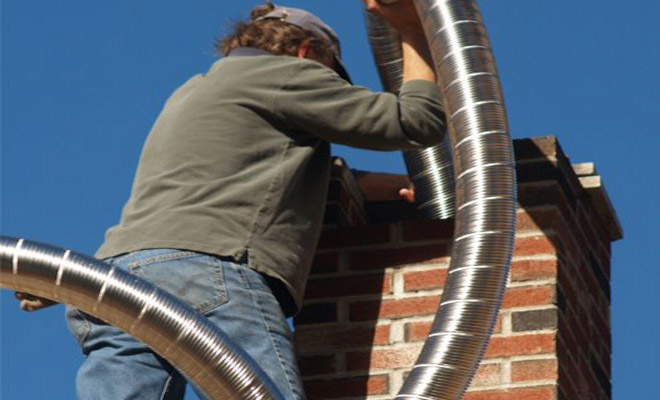
Twin Walled Stainless Steel Chimney Liner Cost (Rigid)
This can be used with all types of stoves and fires. It has a push/fit system for installation, and the walls are insulated for maintaining flue gas temperature. It can also be used free-standing directly from the appliance and can be used where there is no chimney and pass safely through floors, walls and the roof.
This type of liner is more expensive than the flexible type and not as straightforward to install. Depending on the manufacturer, they have a guarantee of between 10-25 years.
You can expect to pay around £850-£1,000 for a twin walled stainless steel liner.
Pumice Chimney Liner Cost
This is a naturally occurring material with excellent insulating and thermal properties. They have a very long-life span of up to 60 years, and the lightweight liners are easy to handle.
The downside is that these liners are really only practical for new build properties or where an old chimney has been demolished and is being rebuilt. They also cannot be used with condensing appliances, including pellet or biomass boilers.
You can expect to pay around £900-£1,300 for a pumice liner.
Concrete Chimney Liner Cost
These are suitable for all types of domestic fire burning solid fuel or gas. They have a guarantee of 25 years but with an expected life of over 50 years and have a thermal shock resistance to 1,000° for half an hour in the event of a chimney fire.
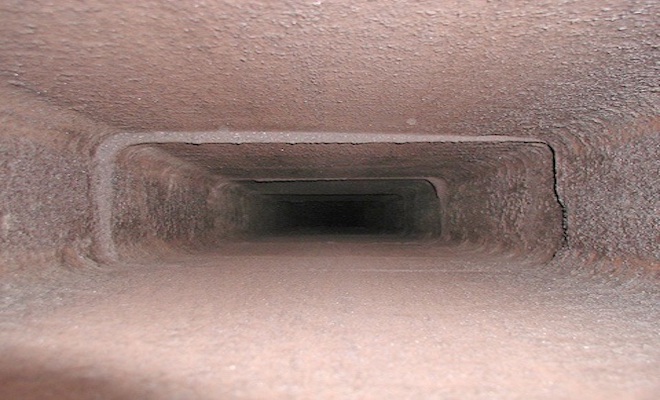
This system is not suitable for DIY installation, and the cost is more than four times that of a flexible liner. This type of flue liner should not be used with a condensing boiler. Concrete gas flue blocks should only be used with gas fires and are not suitable for solid fuel.
You can expect to pay around £1,000-£1,500 for a concrete liner.
Clay Chimney Liner Cost
Clay chimney liners have a long expected life of 50 years and come with a guarantee of 20-25 years. They are suitable for use with wood, multi-fuel, oil and gas. In respect of cost, clay liners are expensive compared to the cheaper stainless-steel options.
To install clay liners, it may be necessary to open up the flue wall, which would incur extra cost, time and a greater degree of disruption. The liners can be lowered down the chimney on a rope too, but either way, it will require a professional installer.
You can expect to pay around £1,100-£1,600 for a clay liner.
Ceramic Chimney Liner Cost
This is a type of cast lining system and as such coats the inside of the flue with a 4mm layer of fireproofing. Benefits include no need to open up the chimney wall, it is a long-term, solution and if required, it is possible to maintain large fireplace openings.
The downside is this is a job for a professional, and it is very difficult to price as each job will be unique and must be assessed individually.
Ceramic chimney liners have a bespoke cost depending on your needs.
Planning Permission & Building Regulations
Relining a chimney in conjunction with installing a heating appliance is classified as building work regardless of which type of flue liner is used and is subject to Building Regulations.
The installation of flues and chimneys is controlled under Building Regulations if done at the same time as installing a heating appliance. This requires the house owner to apply to Building Control before work commences or to employ the services of a person in a recognised scheme such as HETAS who can self-certify their work.
However, replacing, fitting or altering a flue liner comes within the Permitted Development rights of the homeowner and therefore planning permission will not be needed. The only exception will be listed buildings and potentially properties within a conservation area.
There may also be restrictions regarding which elevation of the property a flue pipe is attached to and allowable height for the flue. It is always prudent to check with the local authority prior to carrying out any works if you are unsure of anything.
Any work completed on a chimney, including fitting a new liner, which is done in conjunction with installing a heating appliance is considered a controlled service. As such, the work must either be done by a competent person or if done by others must be inspected and approved by the Building Control department of the local authority.
Document J is a government-approved document which details the requirements of Building Regulations in relation to combustion appliances, and this applies to flues and chimneys. The document can also be found on the Planning Portal.
Check List and Notice Plate
When a chimney has been lined or relined, it is a Building Regulation requirement that a Check List and a Notice Plate are filled in with the latter displayed in an accessible position. The Check List ensures that the installation has been done properly.
The information on the Notice Plate should be a record of the installation, the type of appliance and the type of fuel that can be used with the chimney. This information should be completed by a competent person, such as a HETAS engineer.
If a HETAS engineer installs the flue liner, then they can sign the work off themselves, but if the homeowner or a none HETAS installer does the work then it is necessary for Building Control to inspect the work, and approve it. They will charge a fee for this; the amount varies from one local authority to another but can be between £200-£300.
What to Look for When Choosing a Chimney Liner
The main considerations when choosing a chimney liner should be:
- Reason for lining/relining - Are you replacing an old liner, installing a new heating appliance such as gas fire or wood burner or renovating an old chimney.
- Cost - What is the budget? Is the cheaper flexible stainless-steel liner going to do the job, or is it more cost-effective to install a higher quality product?
- Durability - How long the differing liner types last and how often you want to be relining the chimney.
- DIY or professional installation - Do you attempt the work yourself to save money or pay a professional installer?
The ease of installation of some of the flue liner products may allow for a DIY job, so this may be a greater consideration for someone who wants to do the work themselves. More complicated systems which need to be done with special equipment and some prior knowledge and training are best left to the professionals.
The type of liner will depend on what is suitable for the chimney, the cost, what appliance it will serve and the condition of the chimney.
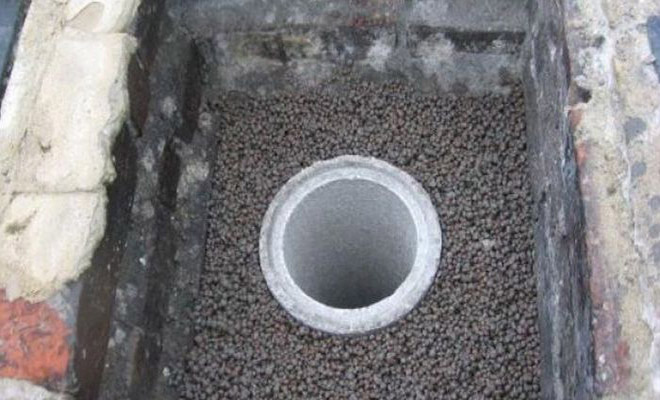
The size will be determined by what the flue is being connected to, e.g. a wood burner, gas fire, open fire or boiler.
It is very important that the right liner is used for the appliance, i.e. Class 2 flue liner is a single wall flexible liner and is only suitable for appliances that burn gas or Kerosene. It is not suitable for temperatures above 260°C. Pumice liner is not suitable for condensing boilers or biomass appliances. All these factors need to be considered when choosing the correct chimney liner.
Chimney Liner Insulation
Chimney liner insulation comes in different forms. Backfill or infill insulation can be a lightweight expanded clay aggregate, or a mineral called vermiculite. They both come in bags of approximately 50-100 litres and are simply poured into the void between the flue liner and the chimney wall. For this system, it is necessary for a register plate to be in place.
For a chimney to perform well and function at its optimum capacity, it is very important that it is well insulated along the entire length. When a flue liner is inserted into the chimney, there is a space between the liner and the wall of the chimney. Chimney liner insulation is designed to fill this gap to provide the flue liner with added heat loss protection and increase the flue’s thermal efficiency.
Insulation is advised if the chimney is on an exterior wall or if the chimney is particularly tall. Similarly, if the diameter of the flue is large then insulating the liner is probably a good investment.
Although it is not necessary to insulate the chimney liner, there are definite advantages to doing so.
The benefits of installing flue liner insulation are:
- ✔ Reducing heat loss through the chimney
- ✔ Higher flue gases and improved chimney draw
- ✔ Reduced risk of condensation
- ✔ More efficient flue leading to longer life
- ✔ Increased energy efficiency
- ✔ Reduction of creosote and tar deposits
Vermiculite (a naturally occurring mineral), Leca (expanded clay aggregate) and Perlite (a siliceous volcanic rock) are the main types of loose infill for insulating a flue liner.
The cost of the expanded clay aggregate insulation is less than £20 for a 50-litre bag.
Vermiculite is available for less than £25 for 100-litres.
Perlite costs under £17 for a 100 litre bag.
It is also possible to insulate the flue liner with a blanket wrap that ties around the length of flexible flue liner, and it costs on average £34 per metre.
Rockwool tubes are also available and cost on average £25 per metre.
Chimney Liner Maintenance and Cleaning
Chimneys age and deteriorate just like everything else and they can eventually begin to leak dangerous smoke and Carbon Monoxide gas. To ensure chimneys are safe, they should be regularly checked as a faulty chimney can be extremely dangerous.
The National Association of Chimney Sweeps advises that wood-burning and coal-burning stoves should be swept quarterly when in use and oil, gas and smokeless fuel burners swept at least once a year. Visual inspection of the chimney both externally and internally should also be done once a year. This can coincide with the chimney sweep.
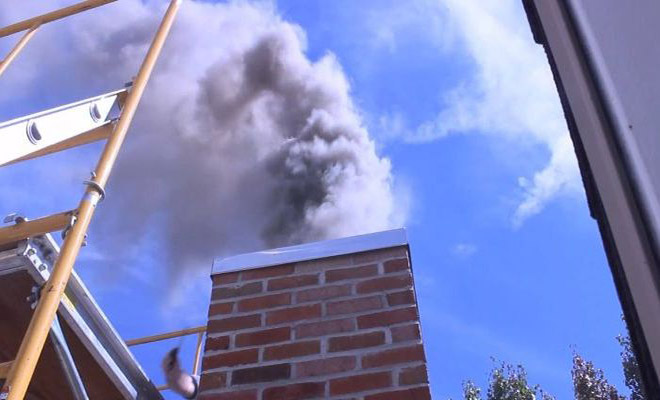
Experienced chimney engineers can carry out smoke integrity tests to identify any potentially dangerous problems. Should you see or smell from your chimney, then you need to get it checked immediately, but remember that the biggest dangers cannot be detected by sight or smell (Carbon Monoxide) so it is vital that your chimney is checked frequently by a competent person.
Having your chimney swept will cost approximately £60 for one chimney flue. If there is more than one flue or chimney, then the price will be reflected by this.
Regular maintenance and cleaning are very important in order to keep the flue liner clear of soot, tar and creosote deposits. These are all combustible materials, and a build-up can increase the chances of a chimney fire from a stray spark or ember.
The accumulated deposits will also impede the flow of flue gases out of the chimney, making the fire or appliance less efficient and potentially releasing dangerous fumes back into the property.
It is, of course, possible to sweep the chimney yourself with the correct equipment. There are a variety of chimney sweeping brushes, rods, accessories, so it is worth careful consideration if you intended to purchase your own.
It is possible to buy a complete kit or individual rods and brush heads as there are a lot to choose from. Drill driven kits are also available. The choice of rod and brush head should be suitable for the flue liner that is going to be swept as items intended for masonry or concrete cleaning may be too harsh for the flexible flue liners and could cause damage.
Chimney brushes cost approximately £18-£20 each, rigid rods cost around £5 each, and the more flexible nylon rods are in the region of £10-£12 each. Drill kits can cost approximately £50.
A professional chimney sweep will have the correct equipment, be familiar with different flue liners and know how to keep mess to a minimum. It is recommended that you have a working flue swept by a registered chimney sweep at least once a year. Of course, it is possible to have one professional sweep a year and carry out additional maintenance and cleaning yourself.
Who are HETAS?
HETAS (Heating Equipment Testing and Approvals Scheme) is an organisation approving biomass and solid fuel heating appliances, fuels and services, including the registration of competent installers and servicing businesses.
They offer comprehensive training for installers of solid fuel, wood and biomass appliances and products. They also offer training to chimney sweeps, local authorities and Building Control officers, among others.
Installers who are registered with HETAS are trained to UKAS standards. UKAS is the United Kingdom Accreditation Service which is a government recognised in the assessment of organisations that provide testing, inspection, calibration and certification services against internationally agreed standards.
HETAS registered installers can certify their own work to confirm that it complies with the relevant building regulations. To put it more simply, it is a way of ensuring that the installer of a stove, boiler or flue liner is competent and qualified to do the job.
Hiring a HETAS registered engineer means that whatever installation they carry out for you will be compliant and conformant to relevant building regulations. This allows peace of mind regarding the safety of the installation and the proper functioning of the appliance.
If there is an issue post-installation, then there is recourse to the installer with the knowledge that if the installer cannot rectify the issue, then it is possible to approach HETAS to intervene.
Cost of Removing Chimney Lining
There are a few reasons for removing a chimney liner; to replace a damaged or worn outliner with a new one, to install an appliance that requires a different flue liner or to permanently close up the chimney. As with installing a flue liner, it is probably advisable to let a professional remove an old chimney liner.
They will have the right equipment and experience to deal with most types of liner and how best to remove it safely. For instance, there may be more than one flue liner in the chimney, and if only one is to be removed, it may be difficult to do so without causing damage to the other liners if you are inexperienced or do not have the right equipment.
If you are doing the work yourself, ensure that you have safe access to the chimney and never work alone. You should also wear protective equipment such as gloves, safety goggles and a dust mask.
As the liner is attached to the chimney pot or cowl, this will need to be detached. This involves working at height and should be done with extreme caution. If the liner is attached to a wood burner or similar via an adapter, then this needs to be de-coupled.
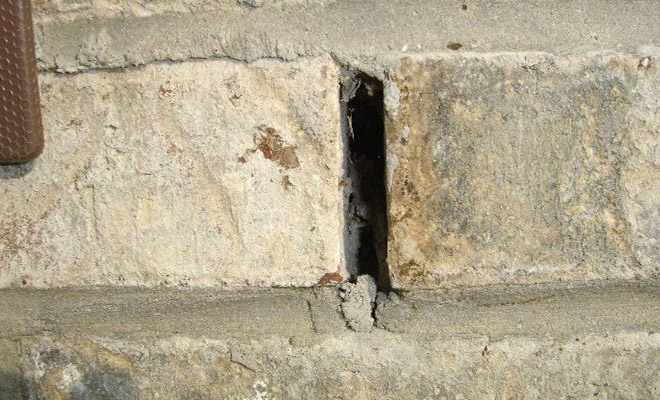
This will require the register/closure plate to be removed. There will probably be soot deposits and debris on top of the closure plate, so it is a good idea to be prepared with dust sheets on the floor and a vacuum cleaner to hand.
Any appliance should be moved to make room for the liner to be taken down through the chimney. Care should be taken while removing the liner as masonry or bricks may be dislodged as it moves through the chimney shaft. This is perhaps why it is better to employ a professional to remove the liner.
A HETAS registered engineer will be able to remove a chimney liner safely and hopefully without damage to the interior of the stack. The cost for an installer with additional labour help would be approximately £250 for a day.
The old liner will need to be disposed of, and you can add this cost to the installers price if they are willing to dispose of it for you. If you need to hire a man and van, it will cost around £150.
Skip hire should not be necessary for the removal of a chimney liner, but if you were to hire a 6-yard skip, it would cost approximately £230 for a week. A 6-metre scaffold tower may be used as a safe working platform and will cost £150-£200 for a week.
FAQs
They are made from a variety of materials including stainless steel, concrete, clay, pumice or ceramic. It also protects the walls of the chimney against heat and corrosion.
The brushes are attached to flexible rods which are fed up the chimney in a circular motion removing soot and debris as it travels upwards.
If the liner is fitted at the same time as a stove or wood burner, then it is controlled work and will need to be approved by the Building Control department of the local authority. There is a fee payable for the work to be signed off; the amount varies between councils.
If a wood burner, gas fire or open fire is installed in a newly built property, then a chimney liner is obligatory.
They also offer training to chimney sweeps, local authorities and Building Control officers.
How to Find and Hire a Tradesman to Line a Chimney
If you don’t wish to carry out the installation of your chimney liner yourself or it is not practical for you to do so, then you will need to hire a tradesman to do the work.
Installers who are HETAS registered have been trained and approved to UKAS standards and can sign off their own work. They send details to building control of the local authority to notify them of the work. This means that the homeowner does not have to have the work inspected and approved by the local council.
It is important to ensure that the person you hire to install your chimney liner has experience of doing similar work. Getting recommendations is a good way to be confident that the installer is experienced and competent. Hiring a HETAS registered engineer is a guarantee that they are trained, competent, experienced and accredited.
Following the work, the HETAS registered installer will provide a certificate of compliance to the homeowner. This is an important record demonstrating that the work was done legally by a competent person and complies with Building Regulations. The certificate is particularly important when the property is being sold, and it also validates home insurance.
Any tradesperson should have appropriate insurance, and it is the responsibility of the homeowner to check that this is the case prior to any work being carried out.
It will cost in the region of £150-£350 per day to hire a professional to install a chimney liner in addition to the cost of the liner and any scaffolding required.
Sources
https://www.flexifluedirect.com/products/chimney-liners/6-flue-liners-accessories/6-rockwool-insulation.html
https://directfluekits.co.uk/complete-flue-liner-installation-kits-5inch-125mm
https://www.tradepriceflues.com/blog/how-much-does-it-cost-to-fit-a-chimney-liner-/
https://verticalchimney.com/blog/how-to-install-chimney-liner/
https://www.stovesareus.co.uk/blog/chimney-liners-explained










